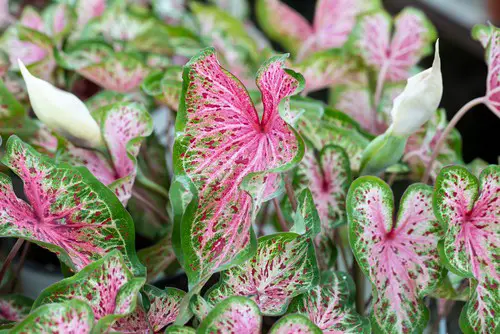The Heart of Jesus plant, also known as Caladium, is a popular houseplant that can add a touch of tropical beauty to any indoor space. However, like any other plant, it is prone to drooping, which can be a sign of various issues. In this article, we will explore the reasons behind Heart of Jesus plant drooping and how to address them.
Understanding the Heart of Jesus plant is essential in identifying the causes of drooping. This plant is native to South America and requires warm temperatures and high humidity to thrive. Its heart-shaped leaves with striking patterns of white, green, and pink make it a popular choice for indoor gardening.
However, improper care and unfavorable growing conditions can cause the plant to droop, wilt, and even die. In the next section, we will discuss the ideal conditions for the Heart of Jesus plant to grow and thrive.
Key Takeaways
- The Heart of Jesus plant, also known as Caladium, is a popular tropical houseplant that can add a touch of beauty to any indoor space.
- Understanding the Heart of Jesus plant is essential in identifying the causes of drooping, which can be a sign of various issues.
- Providing ideal growing conditions, proper care, and recognizing and addressing common problems can help maintain a healthy Heart of Jesus plant.
Learn more on why your favorite plants are drooping:
Understanding Heart of Jesus Plant
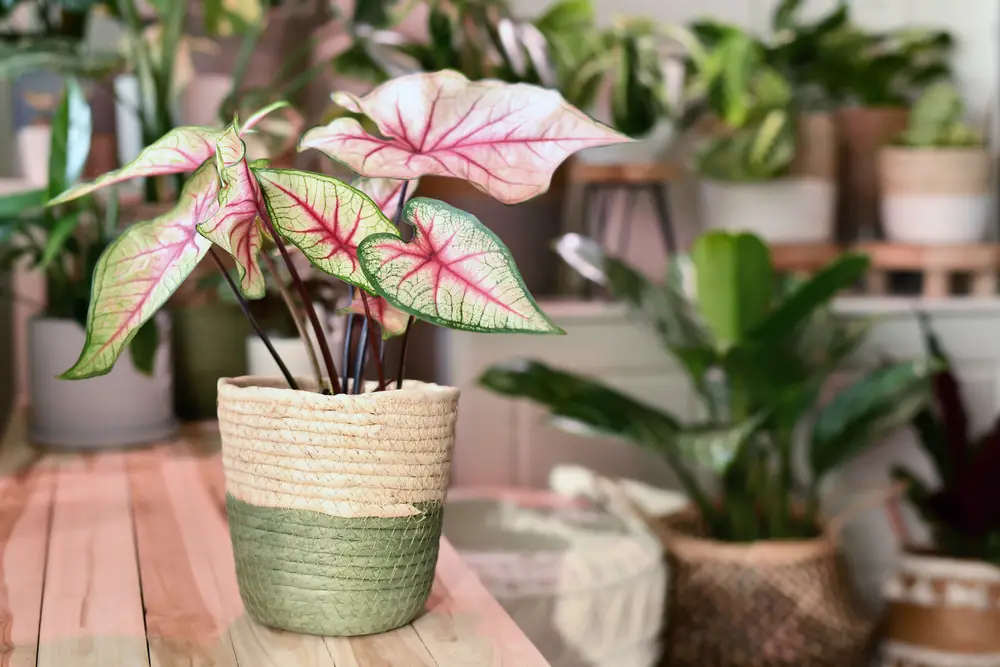
Heart of Jesus plant, also known as Caladium, is a popular houseplant that is native to South America. It is a hybrid plant that has been cultivated into many different cultivars.
The plant is known for its attractive, papery thin, and bi-colored leaves that resemble angel wings or elephant ears. The Heart of Jesus plant is also a type of prayer plant, which means its leaves fold up at night as if in prayer.
The Heart of Jesus plant is a relatively easy plant to care for, but it can be prone to drooping if its needs are not met. One of the most common reasons for drooping is overwatering.
The plant prefers evenly moist soil, but it can be sensitive to waterlogged soil. It is important to allow the soil to dry out slightly between waterings to prevent root rot.
Another reason for drooping can be underwatering. The plant needs regular watering during its growing season, and it may need more frequent watering during hot, dry weather. The plant does not tolerate drought well, and it may droop if it becomes too dry.
The Heart of Jesus plant also requires bright, indirect light to thrive. If it is placed in a location with insufficient light, it may droop and become leggy. It is important to avoid direct sunlight, as this can scorch the leaves and cause them to droop.
Ideal Conditions for Growth
1. Light Requirements
The Heart of Jesus plant prefers bright indirect light, avoiding prolonged exposure to direct sunlight, especially in the spring and summer. Direct sun can scorch and damage the leaves, causing them to droop. Therefore, it is necessary to rotate the plant every other day to prevent amorphic growth.
2. Temperature and Humidity
Above 70ºF (21ºC) is the best temperature to provide, and no lower than 60ºF (15ºC).
In their natural habitat, the Heart of Jesus plant grows in shaded areas. Indoors, that can be artificially provided with a fairly bright room, without direct sunlight. Low humidity can cause the leaves to droop, so it is important to keep the plant in a location with moderate humidity.
3. Soil Type
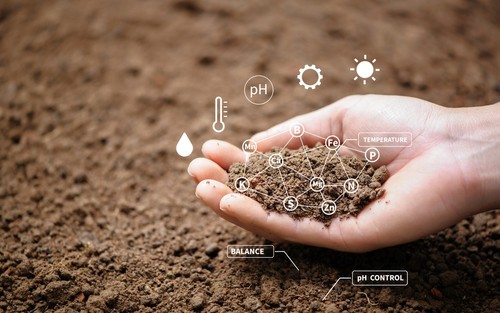
The Heart of Jesus plant prefers well-draining soil that can absorb water evenly. Such plants need regular watering in their growing seasons. The best method to follow is to let the topsoil dry out a bit before watering the plant again.
Unnecessary watering may cause root rot or yellowing of leaves, while underwatering may cause wilting, no growth, leaf tips turning brown, and drooping.
4. Location
The Heart of Jesus plant thrives in partial shady spots getting diffused sunlight. A location that is too dark will cause the variegations (foliar patterns) to weaken, leaving you with just a green plant. Therefore, it is necessary to keep the plant in a fairly bright room, without direct sunlight.
Proper Care for Heart of Jesus Plant
1. Watering
Proper watering is essential for the Heart of Jesus plant’s health. Overwatering or underwatering can lead to drooping leaves, yellowing, and root rot. The plant should be watered regularly during its growing season, which is usually from spring to fall.
The topsoil should be allowed to dry out slightly before watering again. The frequency of watering will depend on the temperature, humidity, and light conditions.
In winter, the plant goes dormant, and its watering needs decrease. However, it still needs some water to survive. Stagnant water should be avoided as it can cause root rot.
2. Fertilizing
The Heart of Jesus plant benefits from regular fertilizing during its growing season. Fertilizer helps the plant grow healthy foliage and vibrant colors. A balanced, water-soluble fertilizer can be applied every two weeks.
However, too much fertilizer can cause salt buildup, which can damage the plant. It is essential to follow the manufacturer’s instructions and not exceed the recommended dosage.
3. Repotting

The Heart of Jesus plant should be repotted every two years or when it outgrows its container. Repotting allows the plant to have more space to grow and access fresh soil. The best time to repot is during the plant’s dormant season, which is in winter.
The plant should be removed from its old container and gently teased apart to separate the roots. The new container should be slightly larger than the old one and filled with fresh potting soil. The plant should be placed in the new container, and the soil should be gently pressed around the roots.
Heart of Jesus Plant Drooping
The Heart of Jesus plant is a beautiful and colorful addition to any garden or indoor space. However, like any plant, it is susceptible to certain problems that can affect its growth and overall health. Here are some common problems that Heart of Jesus plant owners may encounter and how to address them.
Pests and Diseases
Heart of Jesus plants are prone to infestations of mealybugs, aphids, and scale. These pests can cause damage to the leaves and stems of the plant, leading to wilting and drooping. To address these pests, owners can use insecticidal soap or neem oil to kill the bugs. Rubbing alcohol can also be used to remove scale insects.
Heart of Jesus plants can also be affected by spider mites, which can cause yellowing leaves and physical damage to the plant. To address spider mites, owners can use a spray of water and dish soap or insecticidal soap to kill the mites.
Wilting and Drooping
Wilting and drooping of the Heart of Jesus plant can be caused by a variety of factors, including overwatering, underwatering, and root rot.
To address these issues, owners should ensure that the plant is getting the right amount of water and that the soil is well-draining. If root rot is suspected, owners can remove the plant from the soil and trim away any damaged roots before replanting in fresh soil.
Physical damage, such as from being knocked over or bumped into, can also cause wilting and drooping of the Heart of Jesus plant. In these cases, owners should remove any damaged leaves or stems and ensure that the plant is in a stable location.
Yellowing Leaves
Yellowing leaves on a Heart of Jesus plant can be a sign of pests and diseases, as well as overwatering or underwatering.
To address these issues, owners should ensure that the plant is getting the right amount of water and that the soil is well-draining. If pests or diseases are suspected, owners can use insecticidal soap or neem oil to kill the bugs or fungus..
Propagation of Heart of Jesus Plant
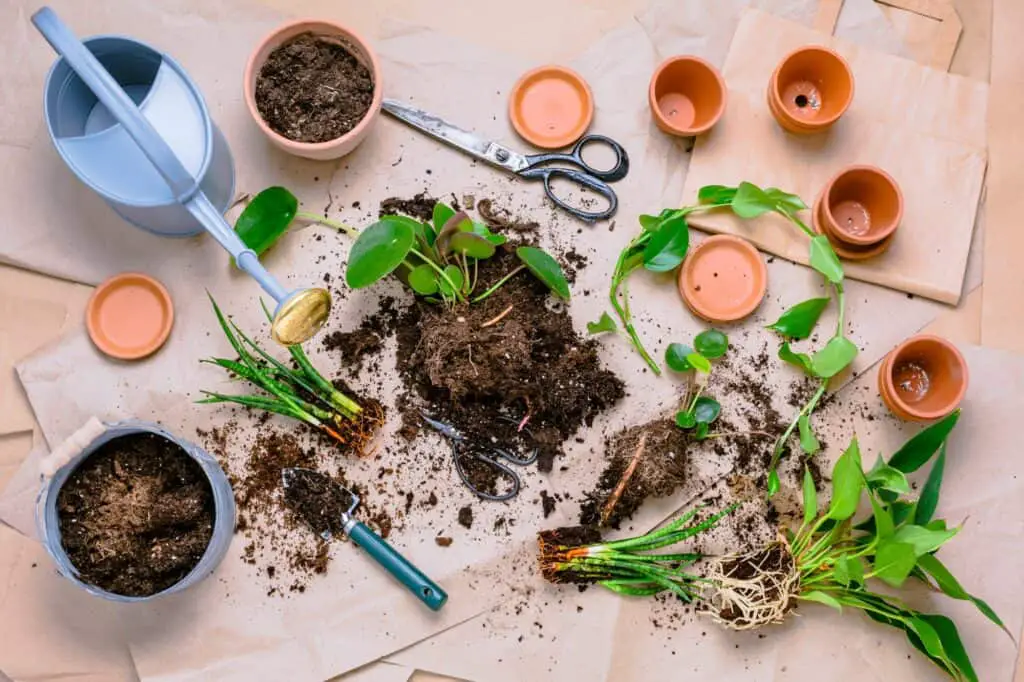
Heart of Jesus plant is a beautiful houseplant that is easy to propagate. The most common method of propagation is through division. The plant is a fast grower, and its bulbs can be easily separated to create new plants.
To propagate the Heart of Jesus plant through division, it is recommended to wear gloves as it has calcium oxalate crystals that can cause skin irritation.
The plant should be watered well, 24 hours before taking the divisions. This will lower down the risk of transplant shock. The entire plant should be taken out of the pot and the bulbs should be separated gently.
The bulbs should be planted in a well-draining soil mix. It is important to keep the soil moist, but not wet, until new growth appears. The plant should be placed in a partially shaded spot, getting diffused sunlight, as intense sunlight harms Caladium. The plant should be rotated every other day to prevent amorphic growth.
Another method of propagation is through stem cuttings in water. The cuttings should be taken from healthy plants and placed in water or mix.
The cuttings should be left in a bright, indirect light and should be checked regularly for root development. Once the roots have developed, the cuttings can be planted in a well-draining soil mix.
Propagation of Heart of Jesus plant is an easy and rewarding process. By following the right steps, gardeners can create new plants that will bring beauty to their homes.
Safety Precautions
Heart of Jesus plant, also known as Caladium, is a beautiful houseplant that adds a touch of nature to any indoor space. However, it is important to take some safety precautions when handling this plant, especially if you have children or pets in your home.
Toxicity
Caladium contains calcium oxalate crystals, which are toxic to humans and pets if ingested. These crystals can cause severe irritation and swelling of the mouth, throat, and digestive system. In some cases, they may even lead to difficulty breathing or swallowing.
It is important to keep the plant out of reach of children and pets, and to avoid touching or ingesting any part of the plant yourself. If you do come into contact with the plant, wash your hands thoroughly with soap and water.
Pets
Heart of Jesus plant is toxic to cats and dogs. If ingested, it can cause vomiting, diarrhea, drooling, and difficulty swallowing. In severe cases, it may even lead to respiratory distress or death.
If you have pets in your home, it is important to keep the plant out of their reach. Consider placing it on a high shelf or in a room that your pets do not have access to.
Calcium Oxalate Crystals
Caladium contains calcium oxalate crystals, which are sharp and can cause skin irritation or injury if touched. It is important to wear gloves when handling the plant, especially when pruning or repotting.
If you do come into contact with the plant, wash the affected area with soap and water and seek medical attention if necessary.
Additional Tips for a Healthy Heart of Jesus Plant
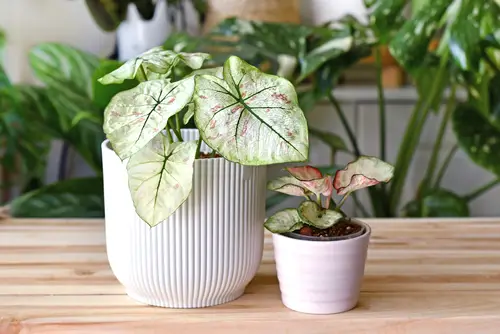
To maintain a healthy Heart of Jesus plant, there are a few additional tips that can be helpful. First and foremost, providing proper support to the plant is essential. The thin stems of the Heart of Jesus plant can cause the foliage to droop. To prevent this, use stakes or plant supports to keep the stems upright.
Another important factor in the health of the Heart of Jesus plant is the condition of its leaves. The leaves of this plant are thin and delicate, and they require proper care to stay healthy. Ensure that the plant is receiving adequate nutrients and oxygen, as this will help to keep the foliage healthy and vibrant.
The soil type is also an important consideration when growing the Heart of Jesus plant. This plant requires well-draining soil that is rich in nutrients. Consider using a soil mix that is specially formulated for houseplants, or amend garden soil with finely ground bark or manure to improve drainage.
For indoor plants, it is important to be aware of dormancy periods. The Heart of Jesus plant may enter a period of dormancy during the winter months, during which time it may lose some of its leaves. This is a natural process, and the plant will typically begin to regrow new foliage in the spring.
When caring for the Heart of Jesus plant, it is also important to be aware of its flowering habits. While this plant is not typically grown for its flowers, it may produce small, inconspicuous blooms during the summer months.
Conclusion
The Heart of Jesus plant is a beautiful addition to any indoor or outdoor garden. However, it is important to note that this plant can be sensitive to overwatering and underwatering.
It requires regular watering during its growing season, but it is important to let the topsoil dry out a bit before watering again to prevent root rot or yellowing of leaves.
If the Heart of Jesus plant is drooping, it could be due to a variety of factors, including underwatering, overwatering, lack of humidity, or pests. It is important to identify the root cause of the issue and take appropriate action to revive the plant.
Some tips to prevent drooping of the Heart of Jesus plant include:
- Watering the plant regularly during its growing season
- Allowing the topsoil to dry out a bit before watering again
- Maintaining proper humidity levels around the plant
- Checking for pests and taking appropriate action if necessary
By following these tips and providing proper care, the Heart of Jesus plant can thrive and add beauty to any garden.
Frequently Asked Questions
Why are my Caladium stems falling over?
Caladium stems can fall over due to overwatering, underwatering, or lack of proper drainage. When the soil is too wet, it can cause root rot, which weakens the roots and makes the stems unable to support the weight of the leaves.
On the other hand, if the soil is too dry, the roots cannot absorb enough water to support the plant, causing the stems to droop.
How can I fix my droopy Caladiums?
To fix droopy Caladiums, you need to identify the cause of the drooping. If the soil is too wet, allow it to dry out before watering again.
If the soil is too dry, water the plant thoroughly and make sure the water drains out of the pot. Repotting the plant in fresh soil can also help if the soil is compacted or has poor drainage.
Why is my Calathea drooping?
Calatheas can droop due to underwatering, overwatering, low humidity, or too much direct sunlight. Ensure that the plant is getting the right amount of water and humidity, and that it is not receiving too much direct sunlight.
Are Caladiums supposed to droop?
Caladiums are known to droop occasionally, especially during the winter months or when they are stressed. However, if the drooping persists, it could be a sign of an underlying issue such as overwatering or underwatering.
Can Caladiums get too much water?
Yes, Caladiums can get too much water. Overwatering can lead to root rot, which weakens the roots and causes the plant to droop. Ensure that the soil has proper drainage and that you are not watering the plant too frequently.
What is wrong with my Caladium?
If your Caladium is drooping, it could be due to overwatering, underwatering, lack of proper drainage, or low humidity. Check the soil moisture, ensure proper drainage, and adjust watering accordingly. If the issue persists, consider repotting the plant in fresh soil.

Hey, I’m Lisa and I’ve been an avid gardener for over 30 years. I love writing, talking and living in the garden! Feel free to connect with me on my socials below

